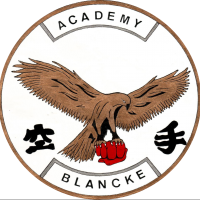Karate Fundamentals - Part 2 Kumite
"Kumite" is the part of karate in which a person trains against one or more adversaries, using the techniques learned from the "
"Kumite" (組手) literally translated means "grappling hands" or in another word it means "sparring" and is one of the three main sections of karate training, along with "Kata" and "Kihon".
In "Kata" we learn only the body movements and the use of techniques for attacks and blocks with imaginary opponent. In "Kumite" we learn to apply all the techniques found in "Kata" against one or many real opponents. The importance of "Kata" and "Kumite" in Karate-do can be compared to the two wheels of a cart.
When Karate was originally practiced in Okinawa, the training was mainly Kata with occasional called "Kake-Dameshi" (tests of strength) , for tsuki (punching) and uke (blocking) techniques. It is only after Karate was introduced in Japan by master "Funakoshi" that an elementary form of Kumite started to be practiced and same importance was given to Kata and Kumite.
As master Funakoshi wrote in his 20 principles (Niju Kun): "Karate begins with Rei and ends with Rei". Its importance is stressed even more when beginning training in kumite.
Kumite is divided in two main groups:
1- Yakusoku Kumite (pre-determined Kumite)
In this type of kumite the attacking technique and target are predetermined and has the following characteristics:
Techniques, place of attacks, Semete (attacker) and Ukete (defender) are pre-determined
In this type of kumite attacker (semete) clearly states the target prior to launching his attack. If the defender (Ukete) fail to block the attack or block too late and contact is made, the attacker would be free from any responsibility (exeptions must be made for differences in technical ability,age, and strength)
We emphasize the training of basic techniques
We acquire the physical (Migamae) and mental (Kigamae) preparation for the execution of a technique
We focus on proper breathing when using the stepping techniques (Unsoku)
We aim at the proper execution of wide range of techniques
we acquire the most important basic principles of fighting which are
Maai (distance and timing)
Tenshin (body rotation and change direction, body displacement)
Tai Sabaki (body shifting, body movement and dodging)
Unsoku (stepping)
Zanshin (awareness)
2- Jiyu Kumite (free Kumite)
In This type of kumite, practitioners are free to test their abilities by employing the attacking and blocking techniques of their choice and has the following characteristics:
Attacks and blocks are free.
This is the final step in kumite. Attacks and blocks are used freely without warning.
All techniques including: "Zuki", "Uke", "Geri" and other techniques must be controlled and full contact is strictly forbidden.
"Jiyu Kumite" is divided into "Kyogi Kumite" (sport) and "Shiai Kumite" (Budo)
3. Each of the "Yakusoku Kumite" and "Jiyu Kumite" has different sub-groups:
Yakusoku Kumite
Oyo Kumite
Happo Kumite
Kumite Kata
Jiyu Kumite
Kyogi Kumite (Sport)
Shiai Kumite (Budo)
Kumite
Tanren Kumite
The main reason of practicing "Tanren Kumite" (training or drill sparring) is to aquire the Physical (Migamae) and the Mental (Kigamae) preperation for the execution of a technique and proper breathing (Kokyu Ho) when using the stepping techniques (Unsuku).
In "Tanren Kumite", "Semete" (attacker) and "Ukete" (defender) facing each other at certain distance and execute their techniques in turn.
"Tanren Kumite" is divided into "Gohon Kumite" and "Sanbon Kumite"
Notes:
The hips must remain very low
Maintain your confidence even the attacker is rushing
Must remain retain a calm mind and react without emotion
When stepping back and blocking, always remember that the techniques are used with the hips and the body and not only with the hand
After the last attack, counter attack (Gyaku Zuki) and "Kiai" will be executed by "Ukete"
Target in "Chudan Zuki" is "Suigetsu" (Solar Plexus)
After delivering the final punch (Gyaku Zuki), the defender maintains the completed position for 2 or 3 seconds. This will help to train and develop the muscles used when performing the technique on the physical side and Zanshin(awareness) on the mental side.
Kihon Kumite
The main reason of practicing "Kihon Kumite" (basic sparring) is to learn different stances while executing basic techniques such as body shifting, proper stances, offensive and defensive technical abilities with proper breathing and body posture, power and spirit.
In "Kihon Kumite" attacker and defender facing each other at certain distance and execute their techniques in turn as pre-agreed.
"Kihon Kumite" is divided into "Kihon Ippon Kumite" and "Kaeshi Ippon Kumite".
Yakusoku Jiyu Kumite
Unlike "Tanren Kumite" and "Kihon Kumite", in "Yakusoku Jiyu Kumite" (Pre-determined free sparring) is more realistic as there is no specific distance between the attacker and defender and techniques are exchanged as fast and as strongly as abilities will permit.
Practicing "Yakusoku Jiyu Kumite" will improve the "Tai Sabaki" (body shifting, body movement), "Tenshin" (body rotation) , "Maai" (distance and timing) and "Zanshin" (awareness).The intention of practicing this type of kumite is for mastering the essential components of actual combat.
"Yakusoku Jiyu Kumite" is divided into "Jiyu Ippon Kumite" and "Okuri Jiyu Ippon Kumite"


